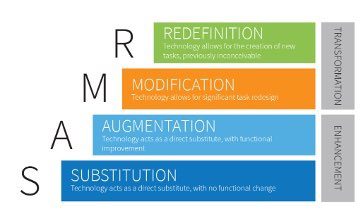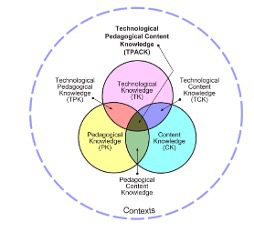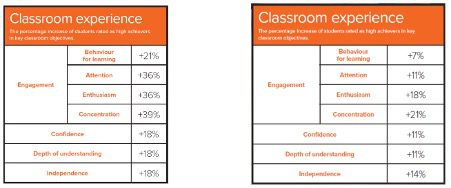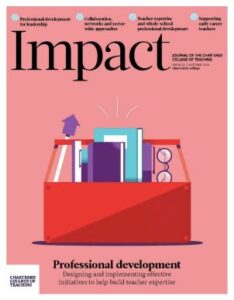Using professional development to support a cultural change in using technology in schools

Phil Herd and Graham Trick, Transform Trust, UK
At the start of 2018, some schools within Transform Trust were introducing more technology through purchasing class sets of iPads. On seeing this, other schools became interested in doing the same if it proved impactful to the children’s learning. In order to support schools, we needed to understand what worked with our early adopters and set up systems that would take others from inception to impact.
Our methodology involved teaming up with an education specialist, Jigsaw24. From this, support for different stakeholders was introduced, as shown in Figure 1.
Figure 1: Overview of support for different stakeholders

Digital Champions development
iPad impact study group
First, an iPad impact group of Digital Champions was created involving six schools. These early-adopting schools had a teacher who would be able to investigate different uses of the iPad in their classrooms, being researchers in their own context. From these, we as a trust would be able to collate the evidence of best practice and disseminate this learning more widely. These research projects focused on integrating technology into everyday classroom practice, i.e. using technology as a pedagogical strategy. Projects included improving vocabulary; reducing teacher workload; spelling and grammar in Year 5; raising attainment in Year 6; and critical thinking in Year 3.
Collaborative creation of skills ladder
In the second year of working with the Digital Champions, support was commissioned from an Apple Distinguished Educator. Where previously network sessions had focused on the integration of technology into the wider curriculum, the focus was now on the computing curriculum. The group collaborated on a set of skills ladders for different elements of the computing curriculum, thus developing subject knowledge. They could then share this with colleagues in school, which allowed for further professional development (PD) around a common curriculum.
Deliberate culture change
To bring about deliberate culture change, Transform Trust worked with our education partner to deliver a series of eight workshops with different stakeholders to ensure that all understood their roles and responsibilities.
Vision
This workshop involved the digital lead, the headteacher, the business manager and the school’s senior leader with responsibility for teaching and learning. Possible vision statements were shared with the group and they had to highlight those that they thought were relevant for their own context. Three important factors need highlighting about these statements:
- Each statement was a feature of best practice – therefore there were no ‘wrong answers’
- Each statement was linked to support for different stakeholders and then linked to a measurable outcome, e.g. all teachers have Apple teacher status
- There was a vision for three different areas: teaching, learning and the environment.
Strategic planning
Having identified elements of best practice that the school wanted to implement, a hands-on workshop involving the school’s SLT followed. Each statement was analysed to ascertain whether it was already a feature of digital provision in the school and how important it was to the overall implementation, i.e. how soon did it need to be done? This created a bespoke timeline for the implementation of the school’s vision and strategy. Each statement came with an action, and an individual directly responsible for each was assigned. Although that individual might not carry out the task, they were to ensure its success against identified criteria.
Teacher development through theoretical frameworks
All teachers in our schools engaged in PD to develop subject knowledge, and the digital leaders developed their pedagogical knowledge. This used three models:
Mandinach and Cline’s Classroom Dynamics model
In Classroom Dynamics: Implementing a Technology-Based Learning Environment (1996), Mandinach and Cline identify that teachers fall into four categories when using technology:
Innovation
- Technology use has transformed the classroom procedures and processes
- I am as digitally literate as I am with pedagogy & subject knowledge
- I innovate and share
Impact
- Technology is widely embedded into the curriculum
- My teaching style is more learner-centered; the teacher is a facilitator
- Co-operative learning, peer tutoring, and project-oriented assignments are common place
Mastery
- I’ve received training
- I have working knowledge of the technology and can support students in the context of my lesson
- I use the technology daily and cope with challenges
- I develop current skills and competence
Survival
- I’m scared of breaking it
- I don’t know what to do
- I often ask for help
- I’m apprehensive to use this in lessons and don’t know how.
Teachers move from the lowest stage (Survival) to the highest (Innovation) as they develop their confidence and competence in integrating technology into their pedagogy and classroom practice.
The long-term PD with schools and teachers was designed to move teachers from survival through to impact and innovation. The move from survival to mastery is focused on skills development, getting to know their new device and the core apps that they use in lessons. From mastery to impact and innovation, there is a shift from skills development to curriculum development through coaching and mentoring.
SAMR model
Based on the research of Dr Ruben Puentedura (2009), the main benefit of the SAMR framework (Figure 2) is in providing a common language with which to frame the discussions of teachers, leading to a clear understanding of how technology could be used. Practical examples were given, with teachers considering and creating further examples across a range of subjects. However, its flaw is in its presentation, which is commonly shown as this stepped, hierarchical approach. This can suggest to teachers that redefinition is the ultimate goal of all technology in a lesson. However, it is perfectly acceptable to have substitution as the goal if it is the level that achieves the biggest impact on learning. We found that this model worked well during PD on subject knowledge.
Figure 2: SAMR model

TPACK model
We also introduced the TPACK model (Mishra and Koehler, 2006) (Figure 3) to further develop our teachers with a strong subject knowledge foundation. This model provided a framework to support the PD for teachers with technology as they moved from mastery to impact through coaching and mentoring, as well as tailor-made sessions.
The expectation is that the teacher being coached brings the pedagogical knowledge and the content knowledge and drives the conversation. The coach, in the early cycles of the coaching process, brings the technical knowledge to help support and drive forward the professional learning. As the teacher becomes more confident with their technical knowledge, the conversation moves from being coach-led to one that is led by the teacher being coached, with the coach being a sounding board. As the teachers move through the cycles of coaching and increase their technical knowledge, they integrate the use of technology in the classroom, with a clear focus on deepening the learning experiences of their students.
Figure 3: TPACK model (Mishra and Koehler, 2006)

Impact
Pre-COVID impact
Through the support we offered to teachers, impact on practice has been seen in three areas:
- teacher pedagogical knowledge
- teacher subject knowledge
- leadership confidence.
This has been evidenced in external reviews from Challenge Partners (a peer review and school improvement organisation), which highlighted the effective practice within schools (Parkdale Primary School, February 2020):
‘Good quality resources are used well. The increased use of digital technology is being trialled very effectively to support and enhance learning. Pupils demonstrated this by using Google Earth and animation mapping to plot the journey of Syrian refugees.’
Classroom impact
To assess the impact of each project, the schools were asked to collect baseline and post-study data on several areas of pupil engagement whenever technology was used. Engagement was tracked through teacher surveys, confidence through pupil surveys and depth of understanding through pre- and post-assessments in comparison to topics with no iPad use. All six schools found positive results, with Figures 4 and 5 showing two typical sets of results.
Figure 4: Classroom experience data at Bulwell St Mary’s Primary School
Figure 5: Classroom experience data at William Booth Primary School

Many schools across the trust used the Apple Teacher programme as a professional development tool during the national lockdowns. Alongside the external provision of professional learning, the trust is using two self-led professional learning programmes. Apple Teacher is a free set of professional learning sessions that help teachers to upskill themselves with iPads. Leading these as internal training sessions has had two distinct advantages, one being reducing professional learning costs: by using the free platform, staff were able to self-study and upskill themselves. The professional learning is based around the use of the iPad’s inbuilt features, iWorks apps, GarageBand and iMovie. This has allowed us to share quick wins and develop a team ethos towards professional learning. Six schools now have nearly all staff qualified, with significant numbers in all schools.
In line with that, we have encouraged our Digital Champions to take part in the Showbie Certified Educator programme; again, this self-study programme has allowed teachers to develop their knowledge of the app and embed its use in their classrooms. Further training from trust staff accelerated the understanding of many teachers, and consequently the TPACK model has been introduced to many more earlier than anticipated.
Prior to the COVID pandemic, it was always the plan to use Showbie as our hybrid learning platform. This became more important during the first lockdown as many of our schools had a large number of devices in school; the impact of accelerated training programmes on quality of learning became evident during the first lockdown and could be seen in our Digital Champions’ classrooms. We therefore decided to accelerate the roll-out of Showbie and iPads. This supported both in-class learning and remote learning throughout the latter part of 2020 and into the last lockdown in early 2021. Parkdale Primary had an OfstedThe Office for Standards in Education, Children’s Services and Skills – a non-ministerial department responsible for inspecting and regulating services that care for children and young people, and services providing education and skills inspection in September 2020, where it was noted how effective the blended learning provision was through the integration of digital technologies. This was a direct result of the increased confidence in teachers through the professional learning received and implemented during remote learning.
Moving beyond COVID, our new normal will be to take the best parts of remote learning with Showbie into the live classroom. This will allow us to leverage the advantages and new pedagogies that our technology-rich learning environments offer, ensuring maximum impact on our children’s outcomes.
References
Mandinach EB and Cline HF (1996) Classroom Dynamics: Implementing a Technology-Based Learning Environment. London: Routledge.
Mishra P and Koehler MJ (2006) Technological pedagogical content knowledge: A framework for teacher knowledge. Teachers College Record 108(6): 1017–1054.
Puentedura RR (2009) As we may teach: educational technology, from theory into practice. In: Ruben R Puentaddura’s Blog. Available at: http://hippasus.com/blog/archives/25 (accessed 3 July 2021).










